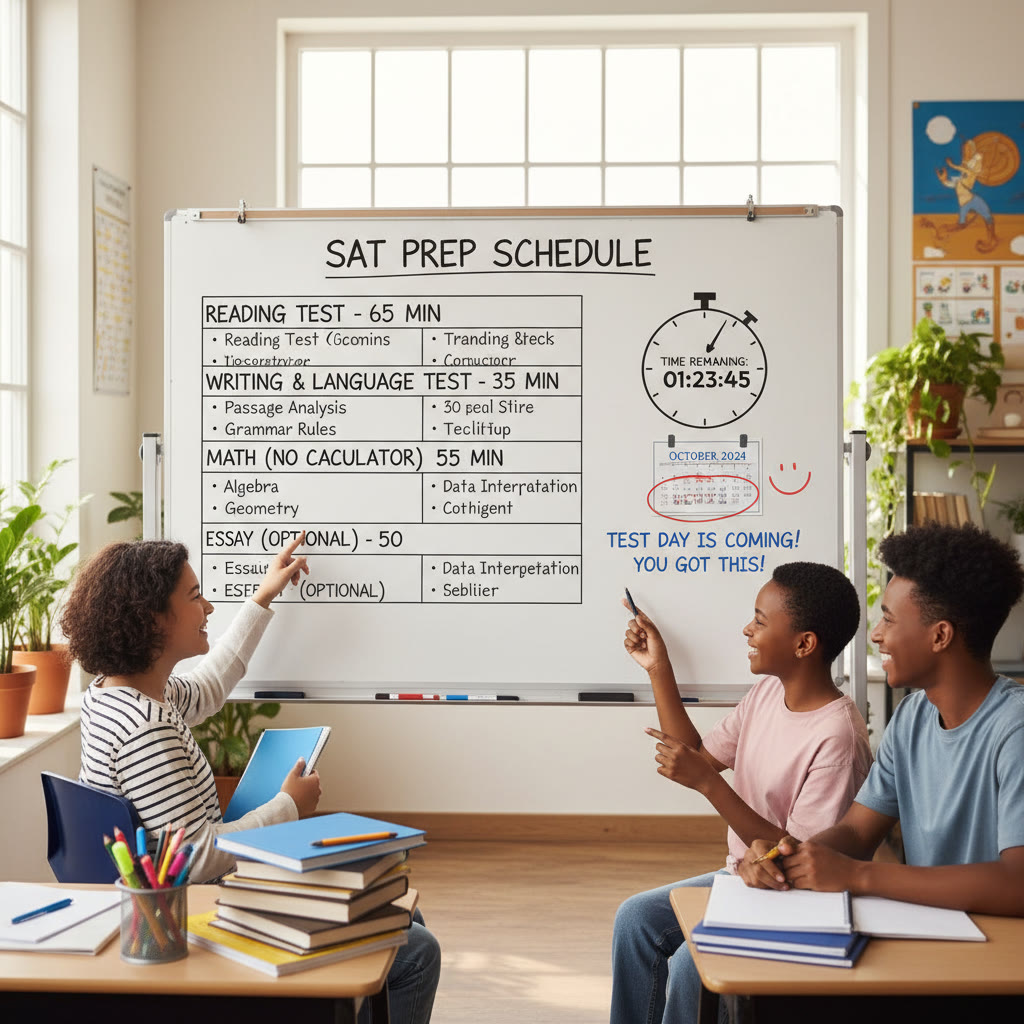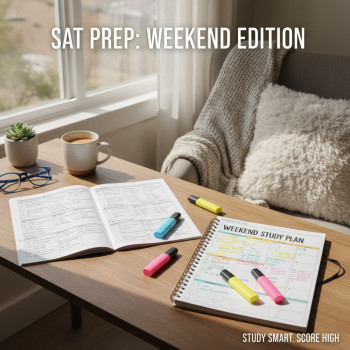Introduction: Why study groups can be your secret weapon
Studying for the SAT can feel like a long solo hike up a steep trail: the material is heavy, motivation dips, and it’s easy to lose your way. A smart study group turns that hike into a well-guided trek with teammates who keep you accountable, challenge your assumptions, and celebrate your small wins. When done right, group study multiplies strengths—one person’s geometry understanding complements another’s clarity on evidence-based reading, and together you troubleshoot timing and test strategies that might be invisible in solo study.
This post is a hands-on playbook. It walks you through forming an effective SAT study group, designing sessions that actually raise scores, avoiding common traps, and blending group work with personalized support. Full disclosure: while group work is powerful, some gaps—like persistent content holes or plateaued practice-test scores—are best addressed with focused 1-on-1 guidance. That’s where Sparkl’s personalized tutoring (tailored study plans, expert tutors, and AI-driven insights) can fit naturally into your plan, giving extra help when the group reaches a sticking point.

What study groups do best (and what they don’t)
Strengths of group study
- Accountability: showing up regularly makes consistency much easier.
- Diverse perspectives: different problem-solving approaches speed up understanding.
- Active learning: teaching someone else is one of the fastest ways to master a concept.
- Emotional support: shared stress is lighter stress—groups normalize the struggle.
- Realistic practice: peer-timed drills and mock sections simulate test pressure well.
Limits to recognize
- Groupthink: repeating incorrect methods without checking answers can reinforce errors.
- Inequality of effort: if a few carry the workload, the group’s value drops.
- Not a substitute for individualized remediation: deep content gaps or chronic timing issues may need one-on-one attention.
Use group study to complement, not replace, targeted individual practice. When problems persist, smart students bring in extra help—like Sparkl’s expert tutors—to convert group momentum into measurable score gains.
How to form an effective SAT study group
Size and composition
Keep groups small and focused: 3–6 members is ideal. Smaller groups make it easier to coordinate, rotate roles, and ensure everyone participates. Aim for a mix of strengths—someone good at algebra, another who shines at grammar rules, a peer who’s disciplined about timing. Similar commitment levels are crucial: a group where everyone shows up prepared will far outperform one where only two people carry the load.
Ground rules (agree up front)
- Meeting cadence: agree on weekly or twice-weekly sessions and a start/stop time.
- Preparation expectation: everyone reads assigned material or completes homework beforehand.
- Device policy: phones on silent; use devices only when doing a timed section or looking up a referenced rule.
- Respect and correction: agree on a friendly way to point out errors and ask clarifying questions.
Roles that keep a session moving
Rotate roles each session so everyone learns different skills and no single person dominates:
- Facilitator: keeps the agenda, time, and transitions smooth.
- Timer: enforces timed drills and breaks.
- Note-taker: records key takeaways, rules, and tricky problems to revisit.
- Explainer: volunteers to teach a short mini-lesson on a chosen topic.
- Quality checker: verifies answers against official explanations and calls out questionable reasoning.
Designing productive sessions: structure that works
Start every session with a clear agenda
Ambiguity kills productivity. A concise agenda (30–60 seconds at the start) sets expectations: today’s focus, who teaches what, and any timed sections. Below is a template agenda for a 90-minute session, which balances learning, practice, and review.
| Session Segment | Minutes | Purpose |
|---|---|---|
| Warm-up drill (short, timed) | 10 | Sharpen timing and focus with 10–12 mixed questions |
| Targeted mini-lesson | 20 | One member teaches a concept (e.g., heart of algebra) with examples |
| Guided practice | 25 | Work through 5–10 problems together; discuss approaches |
| Timed section or drill | 20 | Simulate test conditions on a set number of questions |
| Review and wrap-up | 15 | Analyze errors, assign homework, share resources |
Why the structure works
This rhythm alternates instruction and active practice—research and classroom experience both show that switching between short instruction and practice helps retention. Short timed segments build stamina without burning people out, and reviewing mistakes together converts errors into reliable learning.
Active learning activities to use in sessions
Sitting and passively reviewing notes won’t cut it. Use activities that force retrieval and reasoning.
- Teach-back: One member explains a rule or strategy to the group. Teaching forces clarity and reveals gaps.
- Error clinics: Bring one incorrect practice-test problem each and diagnose why the mistake happened—concept misunderstanding, careless error, or timing panic?
- Timed relay: Split a section into blocks; each person solves one question and passes their reasoning to the next person for verification.
- Role-play tester/tutor: One person takes a timed mini-section while another proctors and then gives immediate feedback on pacing and technique.
- Mixed-topic warm-ups: 10 questions from across sections mimic the unpredictability of the official test and strengthen mental switching.
Example: Turning a wrong answer into learning
Suppose a student misses a reading question because they relied on a paraphrase in the passage rather than the author’s actual words. The group can:
- Identify the misstep: paraphrase versus textual evidence.
- Rewrite the correct answer with direct quotes or line references.
- Create a 30-second rule-of-thumb: “If the answer requires evidence, point to a line number.”
- Assign a tiny homework: find three practice questions to apply this rule.
That converts a one-off error into a permanent strategy.
Measuring progress: what to track and why
To know if the group is effective you need clear metrics. Track these consistently:
- Practice test scores and subsection breakdowns (Math No-Calculator, Math Calculator, Reading, Writing & Language).
- Average time per question on timed drills.
- Error categories: careless mistakes, concept gaps, misreading, pacing errors.
- Attendance and preparation rate (how often members show up ready).
Sample progress snapshot
| Metric | Week 1 | Week 6 | Goal |
|---|---|---|---|
| Full practice test score (average) | 1080 | 1190 | 1250+ |
| Timing errors (avg per test) | 12 | 6 | <4 |
| Homework completion | 60% | 90% | 90%+ |
These snapshots help the group decide whether to double down on content review, focus on timing, or invite individualized help. If a member stalls despite consistent group effort, an expert tutor or AI-driven diagnostic can pinpoint the issue quickly; that’s where Sparkl’s tailored study plans and 1-on-1 guidance can accelerate progress without derailing the group’s rhythm.
Common pitfalls and how to fix them
Pitfall: people come unprepared
Fix: institute a tiny, unavoidable accountability habit. For example, ask each member to bring one pre-solved problem (with work) for discussion. If someone misses this twice, have a private check-in to re-establish commitment.
Pitfall: the group stagnates and repeats the same errors
Fix: use evidence-based checking. Require that when someone teaches a method, they also show the official explanation or cite the rule that justifies it. Rotate the quality-checker role so verification becomes standard practice.
Pitfall: domination by one member
Fix: strictly enforce role rotation and set speaking time limits during discussion. Use the facilitator to ensure quieter voices are invited to explain their approach.
Blending group sessions with individual practice
Group work amplifies learning, but solo practice is where raw score gains happen. Structure your weekly plan so group sessions target strategies, clarify misunderstandings, and simulate conditions, while individual time focuses on deliberate practice and spaced repetition.
Weekly rhythm example
- Monday: Individual practice test or diagnostic (timed)
- Wednesday: Group session—reviews test, error clinic, targeted mini-lesson
- Friday: Individual targeted practice (30–60 minutes on weaknesses)
- Weekend: Full-length practice test every 2–3 weeks
When your group reaches a challenging concept (like advanced geometry or complex grammar rules), consider short-term 1-on-1 tutoring to break the logjam. Sparkl’s expert tutors can offer focused sessions and AI-driven insights that inform the group’s next set of activities—think of tutoring as a surgical tool that complements the group’s broad approach.
Sample 8-week group SAT plan
Below is a practical 8-week roadmap you can adapt to an upcoming test date. The plan assumes a baseline of moderate preparation and a group that meets twice weekly for 90 minutes.
| Week | Focus | Group Activities | Individual Homework |
|---|---|---|---|
| 1 | Baseline diagnostic & goal setting | Take diagnostic; set score goals; assign roles | Review diagnostic mistakes; create personal targets |
| 2 | Heart of Algebra & grammar fundamentals | Teach-back on core rules; timed drills | Targeted practice sets (30–45 min/day) |
| 3 | Problem-solving & data analysis | Group problem deep-dive; error clinic | Practice concepts missed in group |
| 4 | Advanced math topics; pacing strategies | Timed calculator sections; pacing feedback | Timed mini-sections; review pacing notes |
| 5 | Reading comprehension strategies | Passage annotation practice; comparative reading | Daily reading of diverse texts (30 min) |
| 6 | Writing & language: clarity and concision | Sentence correction drills; peer editing | Mixed practice sets; review common grammar traps |
| 7 | Full practice test & analysis | Take simulated test; group error analysis | Triage problems from the test; extra drills |
| 8 | Fine-tuning & test readiness | Rapid review, strategy refresh, mental prep | Light practice; rest and sleep routine |
This plan leaves room for adaptation. If the group discovers a recurring weak area early, swap weeks to prioritize that topic. If one member needs extra help, a short Sparkl tutoring block—targeted 1-on-1 sessions with an expert tutor—can get them back on pace without slowing the group.
Real-world examples and quick scripts
Script for a 5-minute teach-back
“I’m explaining why we eliminate B and D here. First, B misreads the passage: it assumes tone rather than evidence. D has a subtle grammar issue—subject-verb agreement—because the subject is plural. The correct choice, C, matches the author’s point and keeps the verb agreement intact. Here’s a one-line rule to remember…”
Script for error analysis
One person presents: “I missed Question 12 because I ran out of time.” The group asks: “Which steps did you take? Where did you spend most time?” They identify a time sink—overworking algebraic manipulation—and propose a timed-practice drill specifically on those problems.
Final tips and mindset
Study groups are as much about psychology as they are about content. The best groups balance empathy with ambition: they push each other, celebrate improvement, and maintain a steady, realistic pace. Keep these last points in mind:
- Small, steady improvements beat bursts of frantic studying.
- Be brutally honest about weak spots—only then can you fix them.
- Use data: track test scores and error types, and let the numbers guide your plan.
- When the group needs a deeper fix, consider short-term 1-on-1 tutoring—Sparkl’s tailored study plans and AI-driven diagnostics are specifically designed to complement group efforts and close stubborn gaps fast.
In the end, the SAT rewards consistent practice, clear strategies, and calm execution. A well-run study group gives you accountability, feedback, and the perspective you need to improve faster than studying alone. Pair that collaborative energy with targeted individualized help when necessary, and you’ll arrive on test day confident, prepared, and ready to perform.

Wrap-up: start small, iterate, and win together
Start with a committed group of three to six people, agree on clear rules, use structured agendas, rotate roles, and focus on active learning. Measure progress with practice tests and error-tracking, and don’t hesitate to add individualized support—like Sparkl’s expert tutors and AI-driven insights—if the group encounters stubborn plateaus. With the right structure, a study group not only improves your SAT score but also makes the preparation process less lonely and more motivating. Gather your team, pick a first agenda, and take that first productive 90-minute step together.













No Comments
Leave a comment Cancel